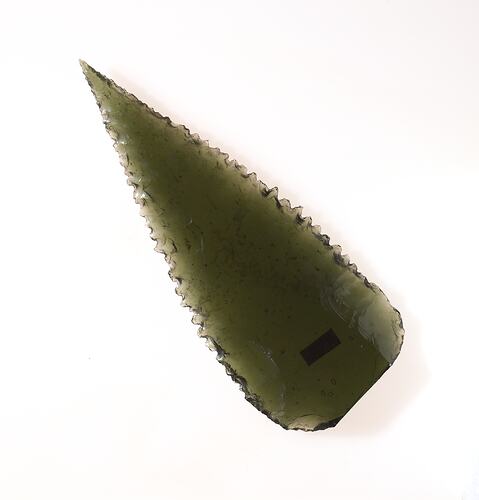Summary
Few Aboriginal stone tools found can match the level of craftsmanship of a Kimberley point and the sophisticated 'pressure-flaking' technique applied to achieve the delicate serrated edges. Before metal tools were introduced tool makers would apply pressure to the material being shaped into the point using bone points, and the Kimberley point was originally made only of stone. The use of glass and various ceramic materials become widespread following contact with Europeans in the late nineteenth century as these were easier materials to work with. One of the main uses was as a spearhead and because of their low weight compared to other spearheads, they could be attached with a small piece of resin to long, slender and light wooden shafts that could be launched at high speed during hunting and fighting. The point would often disengage from the shaft when it hit the target. They were also used as knives to cut up meat for example, and were sometimes used in ceremonies including circumcisions. Some Kimberley points were believed to have magical properties with at least one group using them in sorcery rituals designed to inflict harm on enemies. A dwindling number of craftsmen in a few remote Aboriginal communities still manufacture these points today.
Kimberley points were traded between Aboriginal groups over vast areas of Australia, and ended up in the Northern Territory and as far east as central Queensland. The edges were protected by wrapping them in wallets made of strips of paperbark (Melaleuca leucadendra) and at times further protected with bird down, fur or bulrushes. It appears that Kimberley blades have been made for more than 1,000 years with radiocarbon dates of 1020 to 1760 BP for material from sites where archaeologists have recovered stone Kimberley blades. Thousands of Kimberley points can be found in public museum and private collections today thought to be due in part to high production in the 1900s to satisfy the demand from collectors.
Physical Description
A spear head made of glass.
More Information
-
Object/Medium
Kimberley point
-
Maker
-
Locality
Specific locality unrecorded, Kimberley, Western Australia, Australia
-
Date Produced
-
Date Collected
-
Exhibition Collection Management
105 mm (Length), 43 mm (Width), 5 mm (Height)
Laying flat
-
Keywords
-
Collection Names
-
Type of item
-
Discipline
-
Category
-
Collecting Areas
